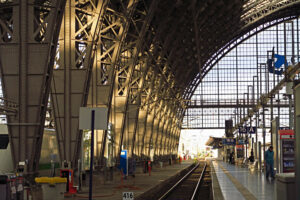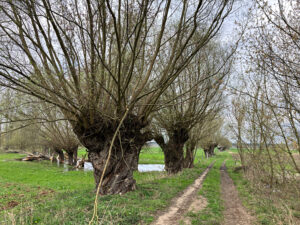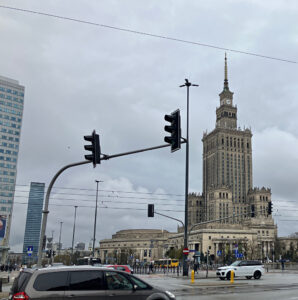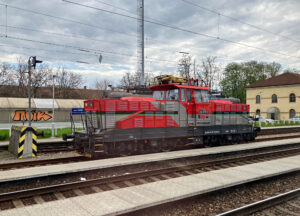Swiss Railways train in Zurich Station
We were fortunate to be invited to Poland by Polish-English friends to spend a week exploring the banks of the Vistula River. Our decision to get there by train (rather than plane) was not just motivated by environmental concerns. This is because we enjoy train travel and it gave us the chance to visit friends in Germany on the way home.
A four-day Interrail pass made such a trip perfectly do-able. The ticket is certainly a breeze to install on a smartphone, but reservations have to be secured in addition. While this can be tricky, especially for Polish trains, it did little to dampen our enthusiasm. What could possibly go wrong?
Leaving the UK
An Interrail pass being only valid abroad, we faced our first hurdle just trying to leave the UK. We live in Kent, but sadly, the Eurostar stop at our local station of Ashford was an early casualty of the pandemic (please see at the end the link to our campaign to reinstate it). International rail travel from Kent now involves a lengthy detour via London St Pancras.
We researched the ferries and found that the once-popular foot passenger routes have been quietly dismantled by ferry companies. DFDS does not allow foot passengers at all while P&O accepts them only on selected crossings, and then the cost for two people is the same as bringing a car.
The simplest option, therefore, was to take the car across the Channel and leave it somewhere safe while we continued by train. Our safe choice turned out to be outside my niece’s home in the Belgian town of Gent. From there we went to Brussels to enjoy some moules with frites and local beer, and found cheap accommodation near Midi station in preparation for an early start.
Brussels to Warsaw
By going to Warsaw, my husband Alex was retracing a journey he had made in 1984 when his father was working in Poland. Back then, he was able to board a train straight off the Harwich-Hook of Holland ferry going direct to Warsaw.
Those days are long gone. The Brussels-Warsaw leg of our journey, which had to take place in a single day under the terms of our Interrail pass, would require four trains. We pinned our hopes on reliable connections at Köln, Berlin and Frankfurt an der Oder, and on a good dollop of luck.
Our luck appeared to run out early when the train from Brussels Midi broke down on its way to Köln. Deutsche Bahn, once the jewel in the crown of European rail, is now showing the strain of years of under-investment. We sat at Aachen while tour guides fulminated and passengers panicked over missed connections.
The advice, when the train restarted, was to change at Köln for a train an hour later on which we did not have seat reservations, accompanied by a large party of elderly travellers. In addition to the discomfort, this plan threatened the whole chain of our journey.

But this is the internet age. A friendly passenger taught us how to locate trains from our laptop, and we saw that another delayed train to Berlin might rescue the situation by meeting our current train at Frankfurt-am-Main. But with our train arriving in Frankfurt at platform 8, and the other departing two minutes later from platform 18, it took all our determination to run, rucksacks on backs, down one set of steps and up another before hurling ourselves into the restaurant car, just in time.
At Berlin we were confronted with that most British of frustrations: a rail-replacement bus service to the border town of Frankfurt an der Oder. The bus took the slow road, waited in every traffic jam and sat behind every dawdling lorry, and we chewed our nails at the thought of missing the Warsaw train.
But we needn’t have because there it stood, waiting patiently for us. We pulled away across the River Oder and the landscape became distinctly Polish, taking on that peculiar aspect that is its legacy from communist days. We sat in the restaurant car enjoying sour zurek soup and raised our beers to our forthcoming holiday.
Our Holiday in Poland

Our friends showed us around Warsaw including Polin, the new and excellent Jewish museum, and the Soviet-era Palace of Culture. We hired a car and travelled gently together along the Vistula that flows between Warsaw and Gdansk.
Our purpose, apart from memory lane for Alex whose father had worked in nearby Włocławek, was to trace the ancient Dutch settlements that dominated the area between the 16th Century and World War II. These populations, called “Olender”, were invited to manage the Polish flood plains in return for being allowed to live under their own laws. Their story is little known and would fill an article in its own right.
We stayed in the spa town of Ciechocinek and the medieval city of Toruń, before making our way back to Warsaw for an early train. Our Interrail pass had two days left which were designed to see us onto Frankfurt-am-Main, and then back to Gent.
The long way home

Our previous journey had taught us that relying on lots of connections is a dicey business with Deutsche Bahn. Then there was the small matter of the bus replacement, which we wanted to avoid. So, what if we changed at Vienna instead of Berlin? The beauty of Interrail is being able to choose any route as long as the relevant reservations are made. This option would be longer but much less stressful than the alternative.
The early train from Warsaw took us through the Czech Republic before reaching Austria for our single connection at Vienna. The German train to Frankfurt-am-Main was crowded and beset by delays due to strike action, and there was no food on board. We eventually arrived, exhausted but safe, at 10pm.
Like Warsaw, Frankfurt-am-Main was substantially rebuilt after World War II. Our German friends took us to the lively city centre for lunch at the top of the Galeria department store, and then to the village of Ockstadt, famous for its cherry blossom then in full bloom.
Finally we left Frankfurt for a direct train to Brussels. We caught our connections to the suburb of Gent where my niece and her partner had kept a watchful eye on our car.
Conclusion
Train travel, like many other things, “ain’t what it used to be”. The predominance of car and air travel has replaced the long-distance trains that plied across European borders. Even German rail, once a watchword for reliability, is disappointing these days.

The future may be brighter. The need to limit our carbon emissions is driving a resurgeance of investment in long-distance rail, including sleeper trains. This is happening across Europe but not in the UK. The Labour Party, which may form the next government, is revamping its rail strategy but makes no mention of international or high-speed rail. Our country’s only international rail connection, the Eurostar, has reduced its service and currently overlooks the Kent stations it once served.
And – finally – Our Campaign
We are calling on the Labour Party to add international rail to its overall transport strategy. We also call on this government, and on whoever forms the next one, to negotiate with Eurostar and its future competitors for a return of international trains to Kent and an increase in the service overall.
If you care about these issues, please add your signature to our petition at https://www.change.org/p/bring-back-eurostar-train-services-to-kent and sign up for the mailing list via our website at https://bringbackeurotrains.com/.
It should be possible, easy even, to cross the Channel as a foot passenger and to manage an Interrail journey without a car. Not everyone has a friendly niece in Gent.
Stephanie Boucher








